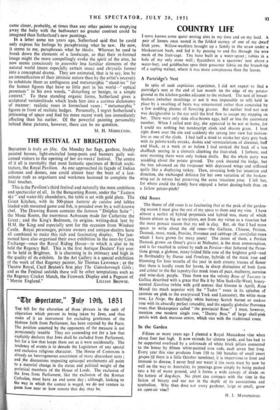Old Roses The theme of old roses is so fascinating
that at the peak of the garden- ing season I must give the rest of my space to them and my vine. I have almost a surfeit of hybrid perpetuals and hybrid teas, many of which bloom almost as big as tea-plates, -not from my virtue as a rosarian but the more prosaic reason that my soil is clay. But, oh that I had more space to write about the old roses—the Gallican, Chinese, Persian, Damask, moss, musk, Provins, Provence and cabbage (R. centifolia) roses which I have grown for many years! The rarest of them, a Persian Damask grown on Omar's grave at Nishapur, is the most commonplace, and is far excelled in colour by such as Persica—that fathered the Perm- liana group, a globose, many-folded little rose of the brightest gold—and in floribundity by Danae and Penelope, hybrids of the musk rose and blooming for four months of the year in such creamy trusses of flower that there is hardly room for leaves, in sharp distinction of both form and colour to the flat tapestry-like musk roses of puce, mulberry, carmine and wine-dark purple. Then there• are the velvety Rose of Tuscany (a Gallica described with a grace that fits it by Miss Sackville-West), honey- scented Xaruhina (white with gold centres that blooms in April), Rosa Mundi (so much superior with the "Tudor " roses in its splashes of carmine on pink to the overpraised York and Lancaster), the white moss rose, La Neige, the dazzlingly white buttony Scotch burnet or cuckoo rose with its absurdly perfect rotundity, and the equally globular Provence roses that Shakespeare called " the provincial Rose." I must, however, mention one modern single rose, " Dainty. Bess," of large shell-pink petals with dark maroon centre, which vies with the traditional roses.


































 Previous page
Previous page